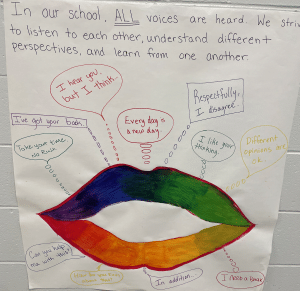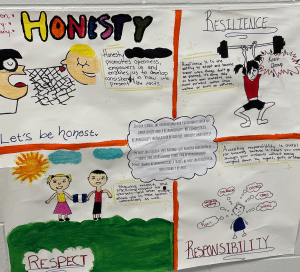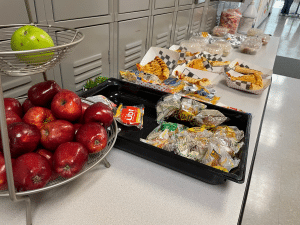Chelsea Opportunity Academy: Relationships, Flexibility, and Competency-Based from the Start
CompetencyWorks Blog
Chelsea Opportunity Academy (COA) is all about meeting the needs of their students. From its inception, COA was designed as a competency-based education (CBE) school. Culture matters deeply to the team at COA, who knows that community and relationships don’t simply follow from work on curriculum, instruction, and assessment. COA students are most often older than the average high school student. Many students are recent immigrants who are learning English and are working part- or full-time in addition to working towards a high school diploma. As of the end of the 2022-23 school year, they have served approximately 350 students and have 137 graduates, many of whom were at high risk for dropping out before coming to COA.

Founded with grant funding from the Barr Foundation’s Engage New England initiative, COA welcomed its first students in 2018. In a prior role leading the Quality Performance Assessment program at the Center for Collaborative Education, I participated in writing the original grant to Barr with Chelsea Public Schools and I was delighted to visit in person. This blog post explores how COA is designed for the flexibility students need, while building the strong relationships that engage or reengage students on a pathway to graduation.
Flexible and Competency-Based by Design

COA students mainly come from schools where they had difficulties with academic engagement due to a variety of reasons, such as work, family responsibilities, and language barriers. For instance, there are COA students paying for immigration lawyer fees and rent, as well as caring for their families at home. Their personal lives were not aligned with how the traditional academic model operates. While serving in his role as assistant principal at Chelsea High School, Ron Schmidt, who led the design team and is COA’s principal, knew that COA students needed a school that could accommodate their needs and circumstances, while also engaging them with meaningful and relevant skill-building.
COA prides itself in being flexible and accommodating to student needs. Transitioning from a traditional learning model to one that works at the pace of students can be a challenging transition for educators. In designing a new model, staff are asked to fulfill two primary needs: building strong, appropriate relationships and flexibility. COA hires intentionally for values-alignment and provides support for teachers to adjust to the school’s new systems. For instance, Adam Aronson, COA Assistant Principal walked me through the “Staff Cookbook” that ensures staff members have access to every core COA document. This includes the mission statement, the instructional vision, operation guides, and half-day schedules. The flexible culture is supported by structures and resources that are clear and transparent.

COA also helps teachers change their mindsets to incorporate the new systems COA put in place to better serve their students. For instance, they work to remove the idea that students are “behind or ahead” and replace it with thinking of the student’s needs and how those needs can be met to support them in building and demonstrating competency. Removing the feeling of judgment allows teachers to serve their students better.
Students as Full Partners in the COA Community
To achieve strong relationships and an inclusive culture, COA regularly includes student opinions and ideas as they create and evolve the school’s protocols and procedures. A COA graduate and current Academic Support Mentor, Jay Jay Pina, stated, “As soon as I got here as a student, it was all about student voices. If I had an opinion, it mattered, and most likely it was going to happen.”

The students also shaped the school’s mission statements and values. Incorporating students’ voices in the process of building an inclusive environment fosters confidence and comfort for students to voice their opinions, especially around those in authority. COA empowers students to have real input and roles in decision-making by having students fulfill leadership roles in planning school activities, including weekly community meetings and field trips.
Fostering Relationships and Community
COA leaders consistently named the importance of fostering strong relationships and cultivating an inclusive community as essential factors in implementing CBE. For the COA students, who were not thriving in their previous schools, activating agency and strengthening their identities as learners is foundational to engaging students as learners. For COA, it is crucial that their students feel that they have a voice and that it matters to them.
A key component in a relationship between teachers and students is trust. The school creates space for personal responsibility, and teachers trust their students to make their own decisions. Students do not have to ask their teachers to use the bathroom or take a phone call. It is important that both the teacher and student build relationships through mutual understanding and communication. COA staff understand that students have needs and obligations outside of school that they must balance with their academic pursuits. COA’s commitment to building strong relationships allows the teacher to know their students as individuals and to effectively provide for what each student needs to succeed.
In cultivating their culture, COA recognizes their students’ differences and how those differences can impact their learning and success at COA. Sustaining the inclusive culture they intentionally created is woven into their ongoing goals. The school actively works to be equitable and culturally responsive for all students. For example, they had discussions surrounding the Uprising for Black Lives, and staff regularly participate in professional development and conferences around anti-racism. Additionally, they recognize how ineffective punitive discipline is for students so they rely on strategies that focus on healing and relationship-building, such as restorative circles and other restorative practices.

Rethinking Attendance to Remove Barriers
COA recognizes that their students have responsibilities that compete with full engagement in school, which is why they adopted an attendance policy that does not penalize students for absences. COA’s policy allows for flexibility for students to learn at the pace that is comfortable for them. This is a major change from the traditional education system, but it removes the pressure of having to meet an academic expectation at a specific time.
Under a traditional learning model, students are pushed to all move at the same pace despite where they are academically. This push can discourage students who need more time to learn and feel confident with the material. For Jay Jay, the flexible model left her feeling comfortable with her learning pace and removed the feelings of being behind her peers. “I have a learning disability, so I would get frustrated to get work done and they’d be like, ‘that’s fine you can try again tomorrow.’”
COA staff have found that alleviating the pressure of the quarterly system by allowing students to complete courses and earn credits as they are ready increases students’ intrinsic motivation. Staff have also found a dramatic increase in the work produced. COA students understand that they set the pace. Their courses are not based on time in class, but rather on work produced, and that all students must complete all requirements to graduate. Students at COA understand that their graduation timeline is in their hands – building agency and responsibility.
Before the pandemic, their daily attendance rate was approximately 40%, but they experienced a decline in attendance during the pandemic. Adam Aronson shares that:
“Approximately, 70% of our students were essential workers during the pandemic. Because of that, our attendance rates decreased even more. Our students had to work more than ever, just to stay afloat. We needed to adapt our academic model so that students could attain a high quality education, while at the same time making our curriculum, our scheduling, and our student support even more flexible.”
Although COA does not factor attendance into whether a student passes a course, they have strategies put in place to increase attendance and remote work engagement. Those strategies include making individual phone calls home to students every day, doing home visits for students who miss a week of participating, and utilizing databases to track students’ remote engagement and in-person attendance.
For each school year, COA develops a strategic plan for increasing attendance by identifying their desired impact, challenges, and strategies to meet these goals. They know the value of being in the school building for making progress in learning and a key area of inquiry for the team is innovation and strategy around improving attendance. At the same time, attendance is a vehicle towards the main focus on helping students learn the skills (and earn the competency-based credits) they need to graduate and be ready to successfully pursue post-secondary plans.
In the next posts we’ll dig into the details and evolution of COA’s competency-based model and examples of what learning opportunities result for learners.
Read the Series
- The Evolution of a Competency-Based Academic Model at Chelsea Opportunity Academy
- How Being in a Competency-Based Learning Environment Prepared Me for College
- A Learner’s CBE Journey
 Laurie Gagnon is the CompetencyWorks Program Director at the Aurora Institute. She leads the work of sharing promising practices shaping the future of K-12 personalized, competency-based education (CBE).
Laurie Gagnon is the CompetencyWorks Program Director at the Aurora Institute. She leads the work of sharing promising practices shaping the future of K-12 personalized, competency-based education (CBE).